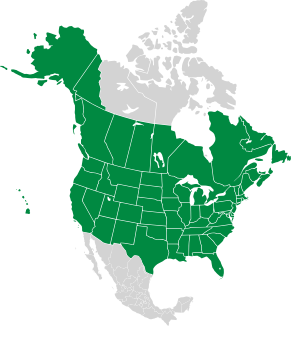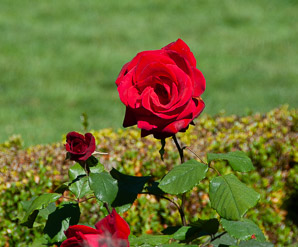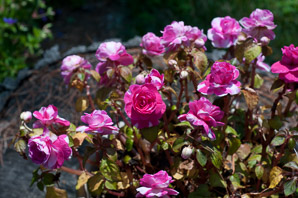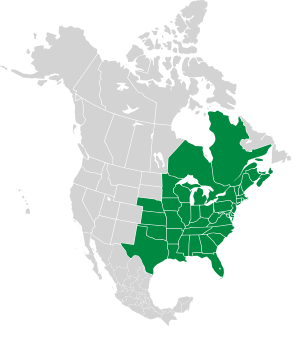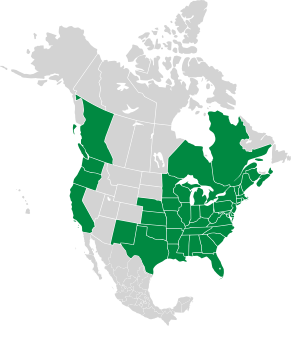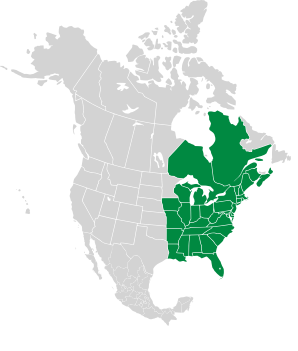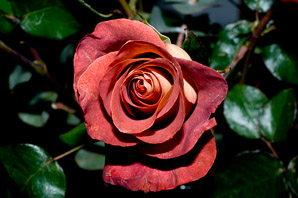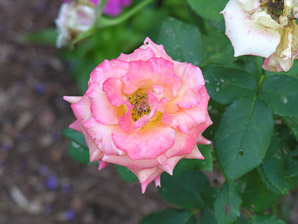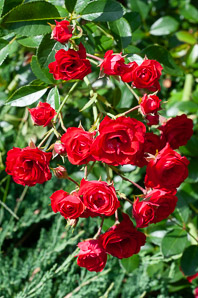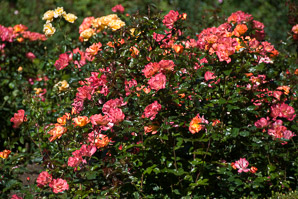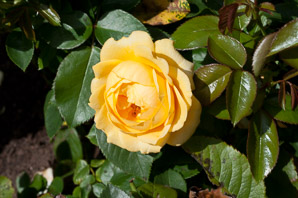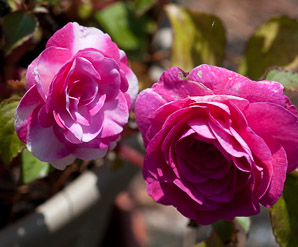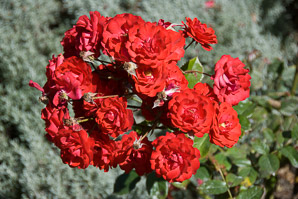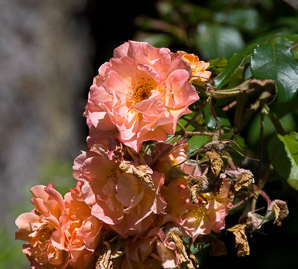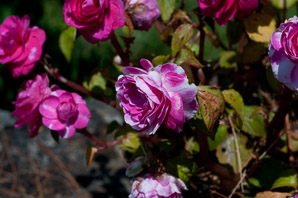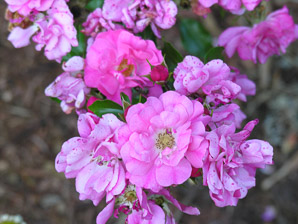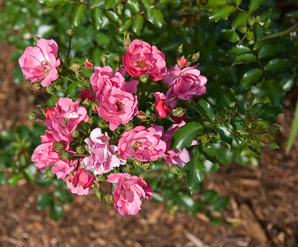
|
Rosa L. Rose, dwarf rose
Many varieties of wild roses are North American natives. Some, like rugosa rose, are from other parts of the world, but have escaped and proven very successful in North America. Innumerable cultivated varieties exist as well. Unfortunately, though, horticulturists as a rule have been more interested in the beauty of the blossoms than in the sublime scent of roses, and the cultivars are nearly odorless. Edibility: The fruit from many wild roses—"rose hips"—is edible, and rich in vitamin C. It can be cooked and used for jam, but it is a challenging process, since the usable portion of the fruit is a thin layer above the seeds, and the seeds are encased in hairlike fibers that can irritate the mouth and digestive tract if accidentally eaten. Fruits are also made into rose hip tea. |
Rose (Rosa) · 8/27/2007 · Shore Acres State Park, Cape Arago, Oregon Dwarf rose (Rosa) · 7/17/2010 · Stan and Connie’s, Falmouth, Maine · ≈ 12 × 8″ (31 × 20 cm) |
|||||||||||||||||||||||||
|
Here are several common species of wild rose: | ||||||||||||||||||||||||||
Rosa carolina |
Rosa multiflora |
Rosa palustris |
||||||||||||||||||||||||
|---|---|---|---|---|---|---|---|---|---|---|---|---|---|---|---|---|---|---|---|---|---|---|---|---|---|---|
| Common Name |  |
 |
 |
|||||||||||||||||||||||
| Plant | A low shrub 1-3′ (30-91 cm) high, erect or sprawling. Stems have straight, needlelike, relatively slender thorns. | 9½-16′ (3-5 m), disheveled and sprawling. It has strong, thorny stems, with thorns that are curved backward. | 6-8′ (1.8-2.4 m) tall, with multiple, thorny stems. Thorns are widely spaced, single or sometimes paired, and hooked, curving backward. | |||||||||||||||||||||||
| Flowers | Solitary, pink (rarely white) with yellow centers, with five petals, fragrant, about ¾-1½″ (1.9-3.8 cm) in diameter. | Abundant white or pinkish flowers, about ½-1½″ (1.5-4 cm) in diameter, with five petals and yellow centers, in large corymbs (flower clusters). | 1½-2″ (3.8-5.8 cm) in diameter, solitary (or in small clusters), light to dark pink, with five petals and strong rose fragrance. They appear from June to July. | |||||||||||||||||||||||
| Leaves | In clusters of five or seven, with a single leaf at the end of each branch. They are ovate (oval, with pointed ends), and serrated. Leaf undersides are bluish and hairless, or with only a few hairs. | Roughly oval in shape, with sharply toothed edges, 1¾-4″ (5-10 cm) long, in groups of 5-11 (usually 9). | Dark green, 1¼-2½″ (3.2-6.3 cm) long, roughly oval with pointed tips, with finely serrated edges. They occur in odd pinnate groups, most commonly with 7 leaflets, sometimes with 5 or 9. | |||||||||||||||||||||||
| Fruit | Rose hips are smooth, red, shiny globes, sometimes somewhat flattened, about ¼-⅜″ (8-12 mm) around. | Orange-red to purplish, ⅛-¼″ (6-8 mm) in diameter. | Red, less than ½″ (1.3 cm) around. | |||||||||||||||||||||||
| Range/ Zones |
|
|
|
|||||||||||||||||||||||
| Habitats | Dry meadows, prairies, fields, woodland openings | Any open area with medium moisture: roadsides, abandoned pastures, open woodlands, thickets | Wet habitats: stream banks, swamps, marshes | |||||||||||||||||||||||
| Type | Wild | Wild | Wild | |||||||||||||||||||||||
| Occurrence | Common | Common; invasive | ||||||||||||||||||||||||
Rosa rubiginosa
Rosa rugosa
Rosa virginiana



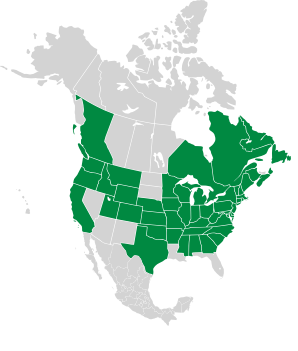
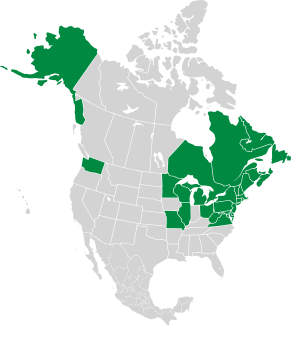
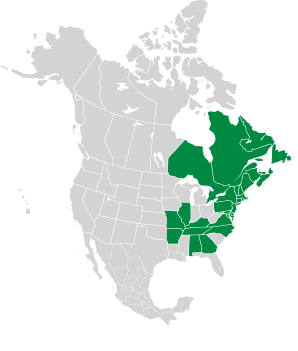
Rose (Rosa) · 6/29/2008 · MacDonalds, Westford · ≈ 7 × 4½″ (17 × 11 cm) ![]() Species not yet identified
Species not yet identified 
Rose (Rosa) · 7/23/2005 · MacDonalds, Westford, Massachusetts ![]() Species not yet identified
Species not yet identified 
(Rosa) · 9/10/2011 · Ellen and Rod’s, Westford, Massachusetts · ≈ 7 × 11″ (18 × 27 cm) ![]() Species not yet identified
Species not yet identified 
Rose (Rosa) · 8/27/2007 · Shore Acres State Park, Cape Arago, Oregon ![]() Species not yet identified
Species not yet identified 
Rosa description by Thomas H. Kent, last updated 16 Sep 2020.
© FloraFinder.org. All rights reserved.
(Rosa) · Variety ‘Julia Child’ · 9/10/2011 · Ellen and Rod’s, Westford, Massachusetts · ≈ 8 × 5″ (19 × 13 cm) ![]() Species not yet identified
Species not yet identified 
Dwarf rose (Rosa) · 7/17/2010 · Stan and Connie’s, Falmouth, Maine · ≈ 6 × 4″ (15 × 10 cm) ![]() Species not yet identified
Species not yet identified 
Rose (Rosa) · 8/27/2007 · Shore Acres State Park, Cape Arago, Oregon ![]() Species not yet identified
Species not yet identified 
Rose (Rosa) · 8/27/2007 · Shore Acres State Park, Cape Arago, Oregon ![]() Species not yet identified
Species not yet identified 
Dwarf rose (Rosa) · 7/17/2010 · Stan and Connie’s, Falmouth, Maine · ≈ 8 × 5″ (19 × 13 cm) ![]() Species not yet identified
Species not yet identified 
Rose (Rosa) · 7/23/2005 · MacDonalds, Westford, Massachusetts ![]() Species not yet identified
Species not yet identified 
Rose (Rosa) · 8/12/2007 · Westford, Massachusetts ![]() Species not yet identified
Species not yet identified 
Range:
